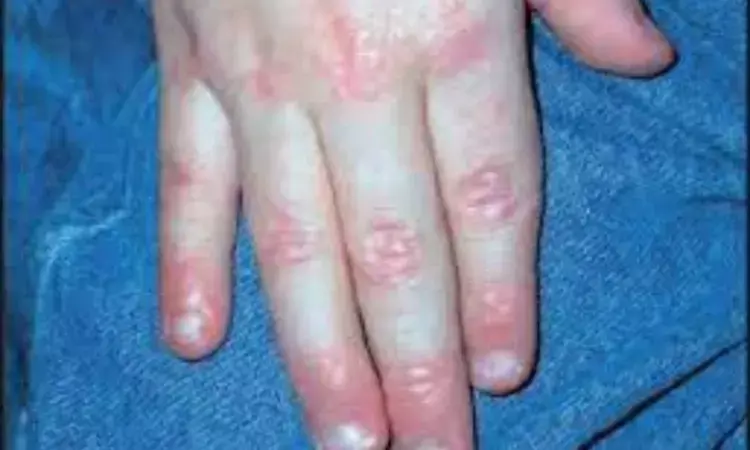- Home
- Medical news & Guidelines
- Anesthesiology
- Cardiology and CTVS
- Critical Care
- Dentistry
- Dermatology
- Diabetes and Endocrinology
- ENT
- Gastroenterology
- Medicine
- Nephrology
- Neurology
- Obstretics-Gynaecology
- Oncology
- Ophthalmology
- Orthopaedics
- Pediatrics-Neonatology
- Psychiatry
- Pulmonology
- Radiology
- Surgery
- Urology
- Laboratory Medicine
- Diet
- Nursing
- Paramedical
- Physiotherapy
- Health news
- Fact Check
- Bone Health Fact Check
- Brain Health Fact Check
- Cancer Related Fact Check
- Child Care Fact Check
- Dental and oral health fact check
- Diabetes and metabolic health fact check
- Diet and Nutrition Fact Check
- Eye and ENT Care Fact Check
- Fitness fact check
- Gut health fact check
- Heart health fact check
- Kidney health fact check
- Medical education fact check
- Men's health fact check
- Respiratory fact check
- Skin and hair care fact check
- Vaccine and Immunization fact check
- Women's health fact check
- AYUSH
- State News
- Andaman and Nicobar Islands
- Andhra Pradesh
- Arunachal Pradesh
- Assam
- Bihar
- Chandigarh
- Chattisgarh
- Dadra and Nagar Haveli
- Daman and Diu
- Delhi
- Goa
- Gujarat
- Haryana
- Himachal Pradesh
- Jammu & Kashmir
- Jharkhand
- Karnataka
- Kerala
- Ladakh
- Lakshadweep
- Madhya Pradesh
- Maharashtra
- Manipur
- Meghalaya
- Mizoram
- Nagaland
- Odisha
- Puducherry
- Punjab
- Rajasthan
- Sikkim
- Tamil Nadu
- Telangana
- Tripura
- Uttar Pradesh
- Uttrakhand
- West Bengal
- Medical Education
- Industry
Apremilast effective in treating Recalcitrant Cutaneous Dermatomyositis

In patients with recalcitrant cutaneous dermatomyositis, apremilast may be a safe and efficacious treatment option according to a recent study published in the JAMA Dermatology.
Cutaneous disease in dermatomyositis has no standardized treatment approach and so presents a challenging task for patients and clinicians.
A study was conducted to study the efficacy and safety of apremilast as add-on therapy in patients with recalcitrant cutaneous dermatomyositis.
This phase 2a, open-label, single-arm nonrandomized controlled trial was conducted at a single centre from June 2018 to June 2021. Participants were 8 patients with recalcitrant cutaneous dermatomyositis, defined by a cutaneous disease activity severity index (CDASI) score greater than 5 despite treatment with steroids, steroid-sparing agents, or both. Data were analyzed from June 2018 to June 2021.
The primary outcome was the overall response rate (ORR) at 3 months. Key secondary outcomes were the safety and toxicity of apremilast and the durability of response at 6 months. The CDASI, muscle score, dermatology life quality index (DLQI), and depression assessments were performed at baseline and regularly until month 7. Skin biopsies were performed at baseline and 3 months after apremilast (defined as 3 months into active apremilast therapy) and tested for gene expression profiling and immunohistochemical stains. Adverse events were assessed using the Common Terminology Criteria for Adverse Events version 5.0.
Results:
- Among 8 patients with recalcitrant cutaneous dermatomyositis, a response was found at 3 months after apremilast among 7 patients (ORR, 87.5%).
- The mean (SD) decrease in CDASI was 12.9 (6.3) points at 3 months (P < .001).
- Apremilast was well tolerated, with no grade 3 or higher adverse events. Sequencing of RNA was performed on skin biopsies taken from 7 patients at baseline and at 3 months after therapy. Appropriate negative (ie, no primary antibody) and positive (ie, tonsil and spleen) controls were stained in parallel with each set of slides studied.
- Of 39 076 expressed genes, there were 195 whose expression changed 2-fold or more at P < .01 (123 downregulated and 72 upregulated genes).
- Gene set enrichment analysis identified 13 pathways in which apremilast was associated with downregulated expression, notably signal transducers and activators of transcription 1 (STAT1), STAT3, interleukin 4 (IL-4), IL-6, IL-12, IL-23, interferon γ (IFNγ), and tumor necrosis factor α (TNFα) pathways.
- In immunohistochemical staining, there was a mean (SD) decrease in phosphorylation levels STAT1 (22.3% [28.3%] positive cells) and STAT3 (13.4% [11.6%] positive cells) at the protein level, a downstream signalling pathway for the downregulated cytokines.
These findings suggest that apremilast was a safe and efficacious add-on treatment in recalcitrant dermatomyositis, with an overall response rate of 87.5% and associations with downregulation of multiple inflammatory pathways.
Reference:
Bitar C, Ninh T, Brag K, et al. Apremilast in Recalcitrant Cutaneous Dermatomyositis: A Nonrandomized Controlled Trial. JAMA Dermatol. Published online October 05, 2022. doi:10.1001/jamadermatol.2022.3917
Keywords:
Bitar C, Ninh T, Brag K, Apremilast, Recalcitrant, Cutaneous, Dermatomyositis, Nonrandomized Controlled Trial, JAMA Dermatology
Dr. Shravani Dali has completed her BDS from Pravara institute of medical sciences, loni. Following which she extensively worked in the healthcare sector for 2+ years. She has been actively involved in writing blogs in field of health and wellness. Currently she is pursuing her Masters of public health-health administration from Tata institute of social sciences. She can be contacted at editorial@medicaldialogues.in.
Dr Kamal Kant Kohli-MBBS, DTCD- a chest specialist with more than 30 years of practice and a flair for writing clinical articles, Dr Kamal Kant Kohli joined Medical Dialogues as a Chief Editor of Medical News. Besides writing articles, as an editor, he proofreads and verifies all the medical content published on Medical Dialogues including those coming from journals, studies,medical conferences,guidelines etc. Email: drkohli@medicaldialogues.in. Contact no. 011-43720751


